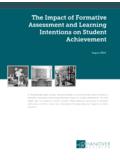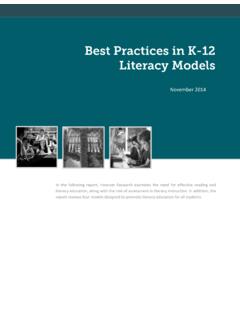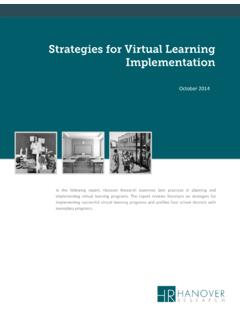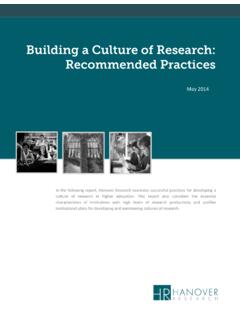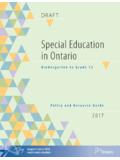Transcription of Best Practices for School Improvement Planning - Featured
1 In the following report, Hanover Research outlines best Practices for School and continuous Improvement Planning , focusing on organizational components and methods for assessment and measurement. In addition, Hanover identifies and describes four effective models for School Improvement . best Practices for School Improvement PlanningHanover Research | 2014 Hanover Research | District Administration Practice 2 TABLE OF CONTENTS Executive Summary and Key Findings .. 3 KEY FINDINGS .. 3 Section I: Essential Components of a School Improvement Plan .. 5 School Improvement FUNDAMENTALS .. 5 THE SCOPE OF School Improvement Planning .. 6 Comprehensive Needs Assessment .. 7 Prioritization Of Needs .. 10 SETTING GOALS SELECTING TARGETS, INDICATORS, AND MILESTONES .. 11 Goal Composition .. 11 Goal Timelines.
2 12 EFFECTIVE ORGANIZATIONAL Practices .. 12 School Principals .. 12 School Improvement Groups .. 13 District Taskforces .. 13 Section II: Implementation, Measurement, and Assessment .. 15 DATA COLLECTION HOW IS School Improvement MEASURED? .. 15 Student Learning .. 16 Demographics .. 19 School Environment .. 20 Implementation .. 21 ONGOING ASSESSMENT AND DATA DRIVEN DECISION MAKING .. 21 COMMUNICATION WITH STAKEHOLDERS .. 23 Section III: Review of Improvement Models .. 24 DAGGETT SYSTEM FOR EFFECTIVE INSTRUCTION .. 24 RESULTS ORIENTED CYCLE OF INQUIRY .. 26 BALANCED SCORECARD MODEL .. 27 MASSACHUSETTS DEPARTMENT OF EDUCATION THEORY OF ACTION MODEL .. 28 Appendix A: Comprehensive Needs Assessment Rubric .. 29 2014 Hanover Research | District Administration Practice3 EXECUTIVE SUMMARY AND KEY FINDINGS In the following report, Hanover Research examines School Improvement and continuous Improvement Planning processes in K 12 education, identifying the most essential components according to best Practices research and well tested models.
3 For example, these essential components include an initial needs assessment, data driven decision making, and feasible goals and benchmarks, among other elements. Hanover also examines effective methods for structuring School and district leadership during School Improvement initiatives, as well as instruments for monitoring Improvement according to academic achievement, behavior, and social emotional learning (SEL) indicators. Lastly, Hanover identifies and describes effective Improvement models. This report comprises the following sections: Section I: This section outlines essential components of School Improvement andcontinuous Improvement plans, as identified across various best Practices reportsand Improvement models Section II: This section examines best Practices for implementing, measuring, andassessing School Improvement across a variety of metrics Section III: This section reviews exemplary Improvement models, as identified byschool Improvement experts and best Practices researchIn addition to synthesizing various secondary sources, Hanover Research conducted interviews with two School Improvement experts.
4 Catherine Barbour, Principal Turnaround Consultant, Education Program, AmericanInstitutes for Research1 Nicole Norton, Director, Funded Programs and School Improvement , MinneapolisPublic Schools2 KEY FINDINGS Effective School Improvement Planning models emphasize comprehensive needsassessments, strategic prioritization of needs, and data driven decision and scholarly research identify the following evidence based models:oDaggett System for Effective InstructionoResults Oriented Cycle of InquiryoBalanced Scorecard Model1 Telephone interview with Catherine Barbour, Principal Turnaround Consultant, Education Program, American Institutes for Research, July 11, 2014. 2 Telephone interview with Nicole Norton, Director, Funded Programs and School Improvement , Minneapolis Public Schools, July 17, 2014. Hanover Research | 2014 Hanover Research | District Administration Practice4 oMassachusetts Department of Education Theory of Action Model Districts should initiate School Improvement Planning with a comprehensive needsassessment in order to systematically determine high need areas.
5 The needsassessment should incorporate both quantitative and qualitative data, includeanalyses of both internal and external variables, and explicitly link results withstudent learning. Additionally, some experts suggest using a third party to conductthe assessment in order to ensure objectivity. Districts should organize School level and district level taskforces to design,implement, and track Improvement efforts. These groups should compriserepresentatives from all groups affected by the Improvement efforts, includingadministrators, teachers, and curriculum directors. Teams should be no larger than12 15 people. At the district level, experts emphasize that the primary focus ofleadership teams should be supporting schools in these efforts, rather thancompliance. Following a comprehensive needs assessment, district leaders must establishrigorous yet attainable goals.
6 Setting exceptionally lofty goals may ultimatelydemoralize key actors and stakeholders. As such, experts recommend startingslow and leaving room for goals to be adjusted upward later. Experts also suggestthat goals be aligned with the district s calendar year and divided into smallincrements, enabling implementers to effectively track progress. Districts should use four primary types of data to evaluate School Improvement :student learning, demographics, School environment, and implementation assess student learning, districts should examine data on standardized tests,curriculum delivery, social and emotional learning, attendance, and other , demographic data allow decision makers to form a thoroughunderstanding of School subpopulations, including special education typically monitor School environment by using student, teacher, and parentclimate surveys.
7 Lastly, tracking the fidelity of implementation enables districts todetermine if planned processes and goals actualize. Throughout the School Improvement process, district leaders should communicateobjectives, progress, and results with all relevant stakeholders. Experts note thatdistricts can build momentum by announcing quick wins when data indicate earlysuccess. However, stakeholders should expect initial Improvement slumps, andshould be cautious when adjusting original objectives and Research | Hanover Research | October 2014 2014 Hanover Research | District Administration Practice5 SECTION I: ESSENTIAL COMPONENTS OF A School Improvement PLAN In the following section, Hanover Research outlines esse ntial components of School Improvement and continuous Improvement Planning gleaned from best Practices research, Improvement models, and expert interviews.
8 School Improvement FUNDAMENTALS Before exploring general best Practices , Hanover first defines the primary goals behind School Improvement Planning and the major components that it comprises. This definition is used to anchor findings and recommendations presented throughout the report. Research and expert interviews define School Improvement and continuous Improvement Planning as a systematic way of Planning School Improvement and tracking it over According to one definition, a School Improvement plan is a road map that sets out the changes a School needs to make to improve the level of student achievement, and shows how and when these changes will be made. 4 A different explanation adds that School Improvement involves quality Improvement , which it defines as the disciplined use of evidence based quantitative and qualitative methods to improve the effectiveness, efficiency, equity, timeliness, or safety of service delivery processes and systems.
9 5 As districts engage in School Improvement and continuous Improvement Planning processes, they must embed this concept of quality Improvement into the daily activities and tasks of its various actors. According to the definitions outlined above, School Improvement and continuous Improvement are distinct from processes such as institutional research and audits, as they aim to reduce the gap between a School s current level of performance and its actual However, research suggests that School districts often fall short of this active Improvement process when designing and implementing their own plans. For instance, many districts publish annual strategic plans that are defined as Improvement plans but are inconsistent with the actual definition of School and continuous Improvement . That is, 3 [1] Telephone interview with Catherine Barbour, Op.
10 Cit. [2] School Improvement Planning : A Handbook, Education Improvement Commission Ontario Ministry ofEducation, 2000, p. 6. [3] Park, S., et al., Continuous Improvement in Education, Carnegie Foundation for the Advancement of Teaching,2013, p. 6. foundation_continuous [4] North Carolina School Improvement Planning Implementation Guide, North Carolina Department of PublicInstruction, September, 2013, p. 18. School Improvement Planning : A Handbook, Op. cit., p. 6. 5 Park, S., et al., Op. cit., p. 4. 6 Ibid. 2014 Hanover Research | District Administration Practice6 many districts draft plans that focus heavily on measuring outcomes but ignore actual processes for Improvement , the means for measuring system outcomes, and how all of these processes may actually function across a To counteract this potential pitfall, experts advise School districts to draft highly specific plans that focus on what tasks will be accomplished and who will accomplish Therefore, School Improvement involves integrating quality Improvement into the daily work of individuals within a School district That is, districts should avoid speaking in vague terms, such as [w]


